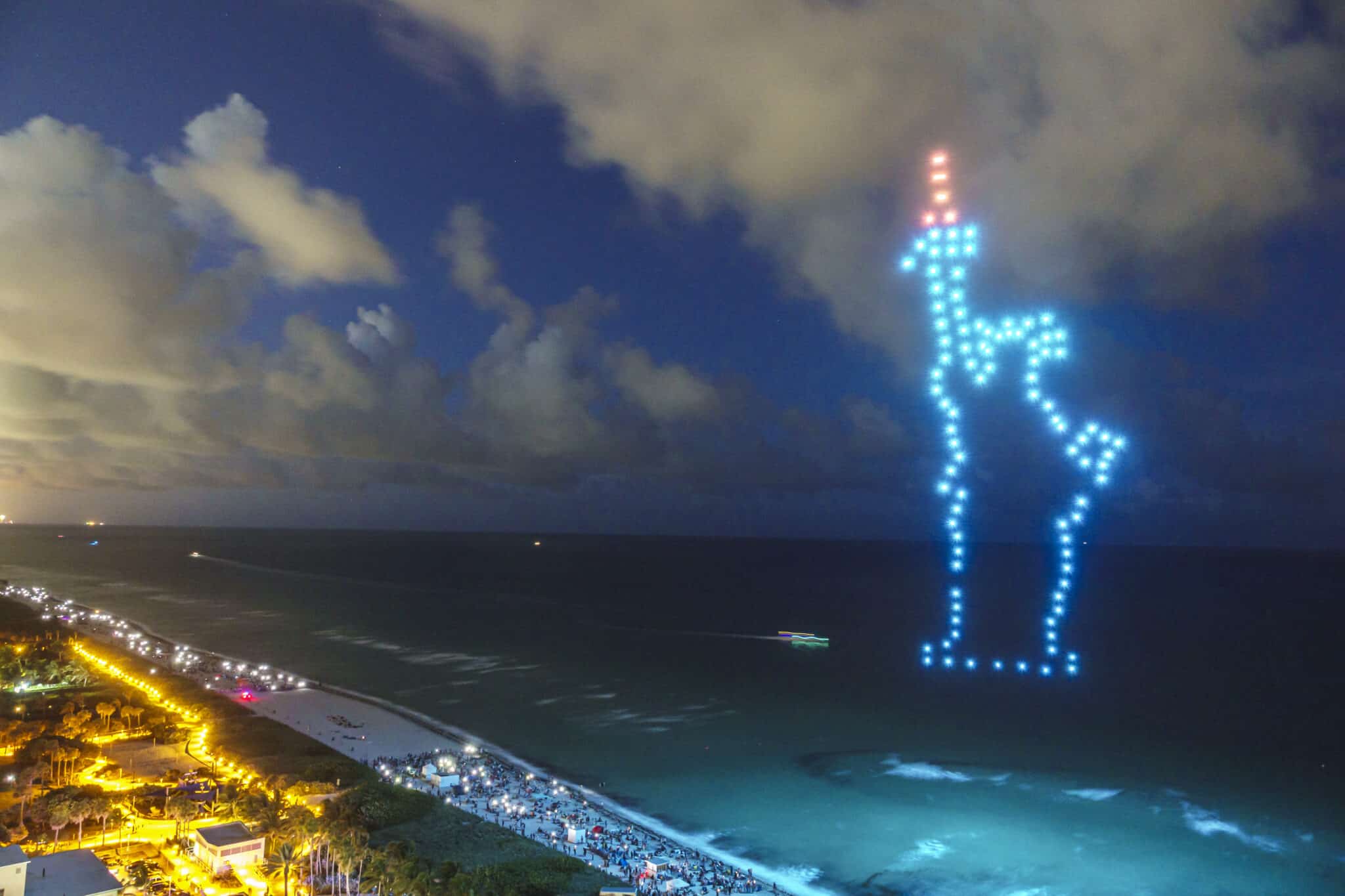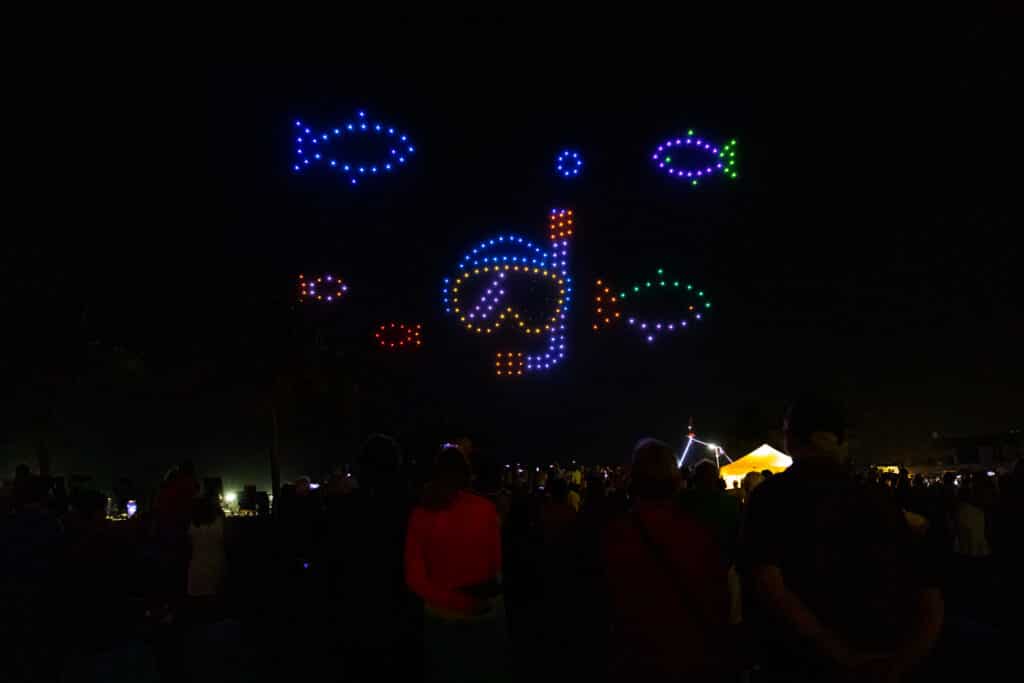Want to Help the Environment This Fourth of July? Skip the Fireworks.
‘Drone fireworks’ dazzle without the negative environmental footprint.

 Why you can trust us
Why you can trust us
Founded in 2005 as an Ohio-based environmental newspaper, EcoWatch is a digital platform dedicated to publishing quality, science-based content on environmental issues, causes, and solutions.
The Fourth of July has become synonymous with barbeques, flag memorabilia and fireworks shows as a celebration of American independence. And, while the latter dazzle the skies, they have harmful repercussions for the environment. Drone fireworks offer an eco-friendly alternative.
The History of Fireworks and the Fourth of July
On the very first anniversary of Independence Day, July 4, 1777, the city of Philadelphia celebrated with bonfires, bells and fireworks, PBS reports. The custom spread to other towns and has remained a mainstay ever since.
To understand what makes these combustible celebrations light up the night skies, we have to understand what they’re made of. “The fireworks that go boom so colorfully every Fourth of July are a chemical cocktail of explosives and pigments,” reported Wired.
Fireworks were – and still are – made with gunpowder, or black powder. According to Green Matters, gunpowder usually contains potassium nitrate (an oxidizer), charcoal or carbon (fuel) and sulfur (an accelerant). Today, other chemicals and additives change the color, shape and “glitter factor” of fireworks, Wired reported.
Environmental Hazards of Traditional Fireworks
The chemicals and additives that give fireworks their bang and brightness also create a lot of air pollution. How much? Around 60,340 metric tons of CO2 annually, Green Matters estimated. To put that one day’s environmental toll into perspective, that’s a little more than 12,000 gas-powered cars emit annually, the report added.
Fireworks also have a large carbon footprint and exacerbate the dangerous effects of climate change. They emit harmful greenhouse gasses like carbon monoxide, carbon dioxide and nitrogen through their chemical combustion reactions, reported 8 Billion Trees. Additionally, handheld sparklers emit a significant amount of ozone, which is another potent greenhouse gas, as a secondary pollutant, a study published in the journal Nature found.
Finally, fireworks also create physical harm in many environments. In some places, falling embers and sparks create dangerous wildfire risk.

Launched above lakes and rivers, the plastic and non-biodegradable casings that house the gunpowder and chemicals also often fall back into these natural spaces and contaminate waterways and marine life. In the Florida Keys, an island chain surrounded by coral reefs and fragile marine habitats, New Year’s Eve celebrations using “biodegradable” fireworks still left hard plastics, metal coils and plastic wrappers littered across the protected waterways and mangrove forests, Keys Weekly reported. A Florida Keys local found these on her annual New Year’s Day kayak cleanup. She noted how these items could damage fragile coral reefs, choke birds and other marine life and entangle manatees, sea turtles, dolphins and other wildlife.
Human Harms from Fireworks
Traditional fireworks also pose a risk to human health. The smoke and air pollutants produced by those big bangs negatively impact air quality by releasing significant amounts of “fine particulate matter,” which are microscopic particles that can penetrate deep into the lungs and bloodstream of humans and animals, Bloomberg reported.
Therefore, this type of air pollution can be dangerous for those with asthma, lung diseases or impaired respiratory health, a study by NCBI found. The effect is worst for pyrotechnicians setting off the fireworks – whether they’re professional or recreational folks setting off backyard displays. Bloomberg reported that prolonged exposure to high levels of air pollution can aggravate difficult breathing and asthma and even lead to death for those with heart or lung disease.
Moreover, Independence Day spikes air pollution so much that it registers on many air-quality sensors installed to notify agencies of dangerous levels of particulates in the air. A Bloomberg analysis found that the Fourth of July air pollution spike shifted air quality from something at the level of Los Angeles early in the day to levels akin to Beijing by 10:00 p.m. due to fireworks launches.
Additionally, National Geographic reported on the “hidden toll” of July 4th fireworks: vulnerable people and communities of color are disproportionately exposed to air pollution from these celebrations. The underlying study, published in the International Journal of Environmental Research and Public Health, found that smoke from fireworks, at its peak, could be comparable to that from wildfires in terms of health impacts.
Finally, the loud bang that accompanies the explosion of gunpowder can be triggering or frightening for veterans and those with PTSD, dogs, babies and those who are hearing impaired.
A Better Choice: Drone Shows
In recent years, drone fireworks displays have been gaining popularity as an environmentally-friendly alternative to traditional fireworks displays. These mesmerizing light shows not only captivate audiences but also offer several compelling benefits over their conventional counterparts, for environmental and human health. As concerns regarding climate change, pollution and animal welfare grow, drone fireworks have emerged as a sustainable and safer option.
The disheartened Florida Keys local who retrieved the fireworks debris from her environment urged, “Maybe it’s time for a change and to protect our fragile ecosystem that we all enjoy and live off down here. Maybe we could switch to a drone show … good for environment and pets.”
Drones used in these displays are small to medium-sized unmanned aerial vehicles that can be driven remotely or autonomously. They also can maintain a controlled, sustained level of flight, hovering or moving into precise patterns. Some drones are also designed specifically to fly safely in constrained air spaces where fireworks would not work, such as indoors, Forbes reported.

Drones used in light shows have GPS sensors and powerful LED lights on them that can be programmed to turn on and off at certain intervals to create more than four billion color combinations, reported Forbes. During most drone fireworks shows, a few hundred to thousands of synchronized drones move in unison to form different formations, similar to how marching band members will create patterns during halftime shows. Pre-programmed flight patterns create animated, color-changing, large-scale displays hundreds of feet in the air. This allows for a greater range of effects than conventional fireworks and presents “almost unlimited opportunities for artistic storytelling in the sky,” Forbes reported. For example, for the 200th birthday of the Florida Keys, a drone show depicted the entire history of the island chain, from ships arriving to railroads being built to the scuba diving industry emerging to modern-day island culture.
All the “Bang” Without the Bad
Drones create all the “bang” without any of the gunpowder and chemicals. This means they result in zero air pollution and leave no toxic chemical fog. In fact, they light up the night and then leave no trace.
Because there are no explosions, drone shows also won’t spark wildfires. They also leave no falling debris or plastic pollution, resulting in safer displays for humans and less choking and entanglement hazards for wildlife.
On the climate change front, drones use electric batteries to power them and don’t produce greenhouse gasses. When paired with renewable energy sources, this becomes a very sustainable option.
Drones also dazzle silently, meaning they can be programmed to move with any music or song, adding another layer of fun to celebrations without the loud bangs and flashes of conventional fireworks.
Drones Gaining Momentum
As cities and countries continue to prioritize sustainability and health, drone shows present a remarkable opportunity to reimagine the way we celebrate. Bordeaux, France put on a spectacular drone show for the Bordeaux Wine Festival, including drones that depicted bottles of their famous burgundy liquid pouring into glasses. In Rostock, Germany, the city used drones to celebrate New Year’s Eve in a spectacle that attracted thousands and garnered positive feedback for its reduced air pollution and noise. Melbourne, Australia also used drones to ring in the new year. The project came to be due to bushfires that had been started by fireworks, and included First Nation artwork and award-winning poetry.
This Fourth of July, drone shows are replacing conventional fireworks in San Diego, Utah, Colorado and across the United States, reported NBC. While some said they’d miss chemical combustions, a young celebrator told NBC San Diego that she preferred the drone displays because traditional fireworks harm bird habitats and leave lots of debris. A different reveler summed it up for NBC, “I’d rather have this. I love the fireworks but we need the environment very, very badly.”
Subscribe to get exclusive updates in our daily newsletter!
By signing up, you agree to the Terms of Use and Privacy Policy & to receive electronic communications from EcoWatch Media Group, which may include marketing promotions, advertisements and sponsored content.

 233k
233k  41k
41k  Subscribe
Subscribe 




